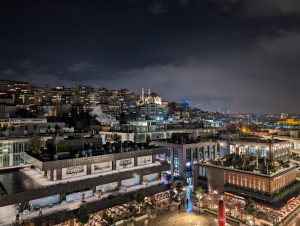For many international carriers, the term “sustainability” often relates to the financial performance of any particular route or airport. When applied to the environment, the idea takes a completely different context.
With the growth of the aviation industry, more global carriers are responsible for increased emissions and garbage from in-flight services. In 2016, the air lines industry contributed to 2% of the world’s overall carbon emissions while flying 3.8 billion passengers around the world. Both of those numbers are on course to double by 2035.
At KLM Royal Dutch Airlines, they are trying to do their part to offset their carbon footprint on the globe and become the world’s most sustainable air line.
“We know climate change is happening, and we know we have to deal with it,” explains Esmee Van Veen, sustainability manager at KLM. “If you look at our numbers, we know as a company, we have this responsibility. If you are such a big company, you have to do something.”
The company hopes to decrease their carbon dioxide emissions by 20 percent in 2020, compared to 2011. In order to achieve this, their focus is on three key areas: reducing their carbon footprint, offering fair-trade opportunities in sourced service items and creating a fair labor environment for employees.
A Renewable Fleet
In order to operate more fuel efficiently as a carrier, KLM is actively renewing their aircraft fleet with newer, lighter aircraft. After retiring their entire Fokker 70 fleet in favor of Boeing and Embraer airframes, the airlines will next ground their remaining Boeing 747 in favor of the Boeing 787 Dreamliner.
“Every two or three months, we will introduce a new plane to replace an old one,” Dr. P.F. Kroesen, environmental strategy manager for KLM, told FlyerTalk. “Our goal is to replace the 747 aircraft with 787-9 and -10 aircraft by 2021. The 787-9 uses approximately 40 percent less fuel in KLM operations.”
Fuel options also help towards the goal of environmental sustainability. In 2009, the carrier became the first air lines to operate aircraft with bio-fuels through their Skyenergy venture. With support of the Dutch government, the air lines currently operates one flight daily between Amsterdam and Los Angeles powered on bio-fuels.
By leaving the jumbo jets behind in favor of composite-built wide-bodies, the air lines maintains a degree of flexibility in their operations. With the new technology KLM can fly to more destinations using less fuel, as opposed to a larger flight servicing fewer destinations.
“[The 747 and Airbus A380] would fit to some destinations, but for flexibility, it would be better to have smaller operations,” Van Veen said about jumbo aircraft. “We want to have connectivity to major airports around the world. For that reason, we need flexible operations.”
Weight savings also applies to inside the cabin as well. Instead of offering traditional newspapers aboard aircraft, the air line has developed a newspaper app, allowing passengers to read all of the day’s headlines from their electronic devices. By moving to digital mediums, the air line can save over 23 tons of paper that would otherwise weigh down flights. Other weight savings include investing in lighter seats, service carts and cargo nets.
“The more you carry with you, the more fuel you need to take to power the aircraft,” Dr. Kroesen notes. “Using a lightweight net for cargo, KLM reduces uses for 6 million liters of fuel – the equivalent energy use of 1,900 Dutch households.”
Asking Passengers to Chip In
Sustainability in the cabin is also extended to the ticket price. Flyers also have the opportunity to pay extra to offset their personal carbon footprint. Through the KLM CO2ZERO program, funds collected go towards projects supported by the World Wildlife Fund in The Netherlands.
Sustainability experts work with the non-profit to identify environmental projects to invest in, ensuring the passenger’s money goes towards offsetting their footprint. In 2016, 35 percent more passengers invested to invest in environmental projects around the world.
Complementing the CO2ZERO initiative, everything served during the course of the flight is ethically and fairly procured as well. From meals to even morning coffee, all items are certified as Fair Trade, Marine Sustainable, or Ecological Egg or Chicken products, while only 100 percent UTZ certified coffee is served on board.
Employees Will Contribute Too
Individual employees also contribute to the airlines’s sustainability initiatives. Old uniforms collected from KLM employees are recycled and turned into the carpeting and curtains found on KLM flights. Additionally, at Amsterdam Airport Schiphol (AMS), the carrier dedicates one gate for experimentation. Called the “X-Gate,” employee ideas on sustainability are tested in a real-world setting to ensure the experiment is successful and can be replicated across flights.
“It’s not only our sustainability department – this is for everyone,” Dr. Kroesen emphasized. “It’s really something the company wants to spread out internally and externally as well.”
While the air lines is focused on weight reduction, efficient fuels and fair advancement opportunities, they are also aware of their responsibility to their passengers. For that reason, flyers in premium cabins can still expect to receive the customary blue delft house for a long time to come, as they only add 4.4 pounds to the flight weight.
“We’re not a budget airline, and we need to focus on customer comfort,” Van Veen said. “We don’t think the houses will go away.”




















